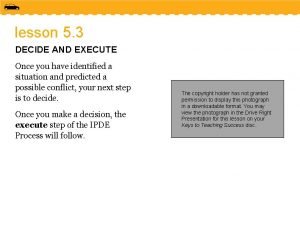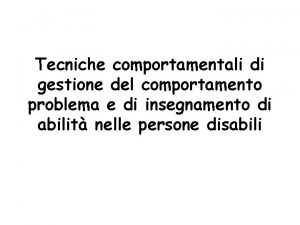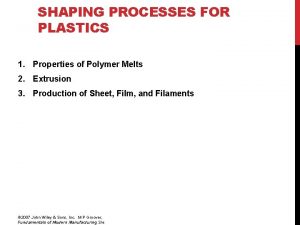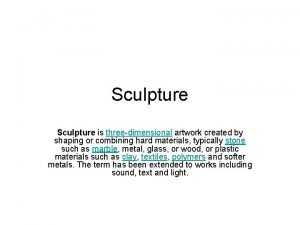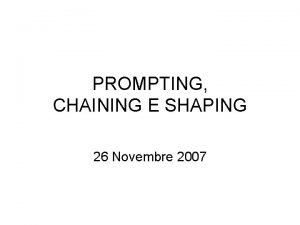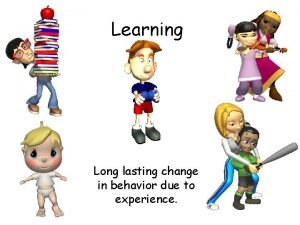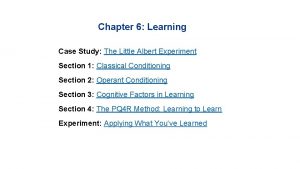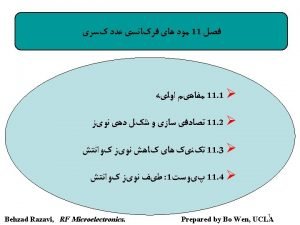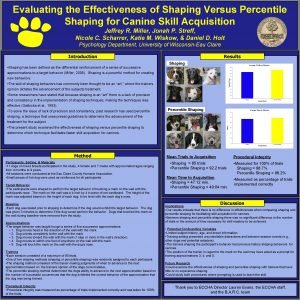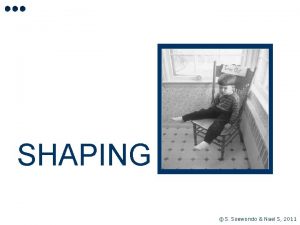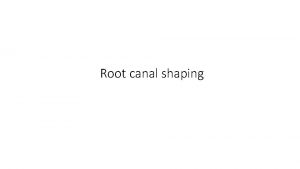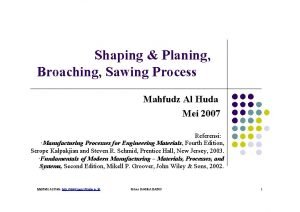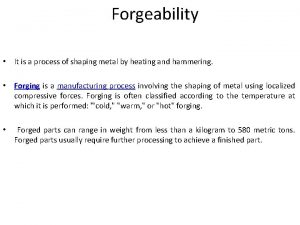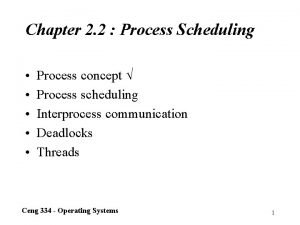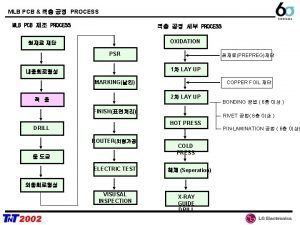Shaping What is Shaping A process where you


























- Slides: 26

Shaping

What is Shaping? �A process where you systematically and differentially reinforce successive approximations to a desired behavior �Used to help learners acquire new behaviors

Differential Reinforcement �Some members of a response class are reinforced (responses that are successively closer to the terminal behavior) �Other members of that response class are not reinforced (responses that are not closer to the terminal behavior)

Response Differentiation �Involves two components: �Differentially reinforce behaviors that resemble the terminal behavior �Carefully changing the criterion for reinforcement �Result �Increase in behaviors successively closer to terminal behavior �Decrease in behaviors that are not successively closer to terminal behavior

Shaping Diagrammed Ø Assume we want to teach a child to turn on the cold water tap in order to get a drink of water. Ø Assume the child already walks to sink and looks at it when he/she is thirsty. Ø Shaping might proceed like this: EO SD Response SR+ Deprived of water for a long period of time Tap on faucet marked with blue dot or letter “C” Walk to sink and look at it Cold water presented Walking to sink and looking at it maintains Response already in repertoire Cooper, Heron, and Heward Applied Behavior Analysis, Second Edition Copyright © 2008 by Pearson Education, Inc. All rights reserved

Shaping Diagrammed Ø Shaping step 1: EO SD Response SO Deprived of water for a long period of time Tap on faucet marked with blue dot or letter “C” Walk to sink and look at it Cold water withheld EO SD Response SR+ Deprived of water for a long period of time Tap on faucet marked with blue dot or letter “C” Point to tap Cold water presented Walking to sink and looking at it when deprived of water decreases Pointing to tap when deprived of water increases

Shaping Diagrammed Ø Shaping step 2: EO SD Response SO Deprived of water for a long period of time Tap on faucet marked with blue dot or letter “C” Point to tap Cold water withheld EO SD Response SR+ Deprived of water for a long period of time Tap on faucet marked with blue dot or letter “C” Touch tap Cold water presented Pointing to tap when deprived of water decreases Touching tap when deprived of water increases

Shaping Diagrammed Ø Shaping step 3: EO SD Response SO Deprived of water for a long period of time Tap on faucet marked with blue dot or letter “C” Touch tap Cold water withheld EO SD Response SR+ Deprived of water for a long period of time Tap on faucet marked with blue dot or letter “C” Grasp tap Cold water presented Touching tap when deprived of water decreases Grasping tap when deprived of water increases

Shaping Diagrammed Ø Shaping step 4: EO SD Response SO Deprived of water for a long period of time Tap on faucet marked with blue dot or letter “C” Grasp tap Cold water withheld EO SD Response SR+ Deprived of water for a long period of time Tap on faucet marked with blue dot or letter “C” Turn tap Cold water presented Grasping tap when deprived of water decreases Terminal Behavior Turning tap when deprived of water increases

Dimensions of Behavior that can be Shaped �Topography � Form of the behavior �Frequency � Number of responses per unit of time �Latency � Time between onset of antecedent stimulus and the occurrence of the behavior �Duration � Total elapsed time for the occurrence of the behavior �Amplitude � Magnitude

Guidelines for Implementing Shaping �Consider Nature of Behavior to be Learned and Resources Available �Select the Terminal Behavior �Determine Criteria for Success �Analyze the Response Class �Eliminate interfering Stimuli �Deprivation of Reinforcers you want to use �Identify the First Behavior to Reinforce �Limit the Number of Approximations at Each Level �Continue Reinforcement when Terminal Behavior is Achieved

Consider Nature of Behavior to be Learned and Resources Available �How far away is current performance from terminal behavior? � This might influence how long shaping will take �What is the availability of staff and other resources? � Remember, this is a labor intensive procedure

Select the Terminal Behavior �The ultimate criterion for selecting a behavior for change: �How will the behavior change contribute to the learner’s independence in gaining reinforcement? �Define the terminal behavior precisely �Then you’ll know when the behavior has occurred

Determine Criteria for Success �How accurate, fast, long, or intensely should the behavior be performed? Under what conditions should it be performed? �Establish norms by � Consulting literature � Observing similar peer group

Analyze the Response Class �Identify the approximations that might be emitted during training BEFORE TRAINNG BEGINS �Trainer is in a better position to “stay ahead of his/her subject” �Can be done by: �Consulting experts in the field �Use published literature �Use videotape of peers to analyze components of a behavior �Perform the target behavior yourself �LIST THEM IN ORDER

Key to Shaping - Deprivation �If possible, deprive the organism of what you want to reinforce it with. �Animals with food. Deprive to 80% of its body weight. �Deprive kid of reinforcer you want to use. 16

Kids �Food �Chocolate Chip Cookies (ccc’s) �M & Ms �Tokens �Money 17

Identify the First Behavior to Reinforce �Behavior should already occur at some level �Behavior should be a member of the targeted response class

Specifics �Eliminate Interfering Stimuli �Eliminate distractions during training �Proceed in Gradual Stages �Be prepared for decrements in performance when you increase criteria �Limit the Number of Approximations at Each Level �Lest the behavior become too firmly established

Continue Reinforcement When the Terminal Behavior is Achieved �The behavior will be lost if the terminal response is not reinforced �Move to a schedule of reinforcement �Thin the schedule

Increasing Efficiency of Shaping �Combine with other discriminative stimuli (e. g. , a prompt) �Verbal cues �Physical guidance �Models

Positive Aspects of Shaping �Teaches new behaviors �Is a positive approach to teaching �Can be combined with other procedures, such as chaining, imitation, etc.

Limitations of Shaping �Can be time consuming �Progress is not always linear and may be erratic �Requires a skillful trainer, who can recognize subtly closer approximations �Can be misapplied (problem or harmful behaviors can be accidentally shaped)

Reverse Shaping Is different from Regular Shaping Start at the end response, then reinforce it. Then two steps before you reinforce it, Then three steps, etc. 24

Examples Teaching a kid to tie their shoes. 25

Summary �Is an extremely useful technique �Can be used with a variety of other techniques �Can be used to change behavior �We use shaping with many behaviors and do not know it �Can be used systematically to manipulate behavior of others in a variety of situations �Weight control �Business relationships �Family relationships �Can take longer than other techniques.
 Particulate processing adalah
Particulate processing adalah Writing brainstorming planning drafting and editing
Writing brainstorming planning drafting and editing Shaping process
Shaping process Shaping manufacturing process
Shaping manufacturing process Shaping tomorrow with you
Shaping tomorrow with you You separate hazards when you adjust your
You separate hazards when you adjust your You say you love rain
You say you love rain Agree or disagree questions about life
Agree or disagree questions about life If you think you can you can poem
If you think you can you can poem Tell me what you eat and i shall tell you what you are
Tell me what you eat and i shall tell you what you are Wherever you go we follow
Wherever you go we follow Prompting fading shaping modeling chaining
Prompting fading shaping modeling chaining Characteristics of polymers
Characteristics of polymers Shaping 2030
Shaping 2030 A 3-d work of art created by shaping or combining materials
A 3-d work of art created by shaping or combining materials Shaping significato
Shaping significato Precision fluency shaping program review
Precision fluency shaping program review Palo alto traffic shaping
Palo alto traffic shaping Operant and classical conditioning
Operant and classical conditioning Skinner puzzle box
Skinner puzzle box Operant conditioning examples
Operant conditioning examples A long lasting change in behavior as a result of experience
A long lasting change in behavior as a result of experience Van riper tekniği
Van riper tekniği Shaping psychology
Shaping psychology Demand sensing and shaping
Demand sensing and shaping Shaping psychology definition
Shaping psychology definition Shaping in operant conditioning
Shaping in operant conditioning





